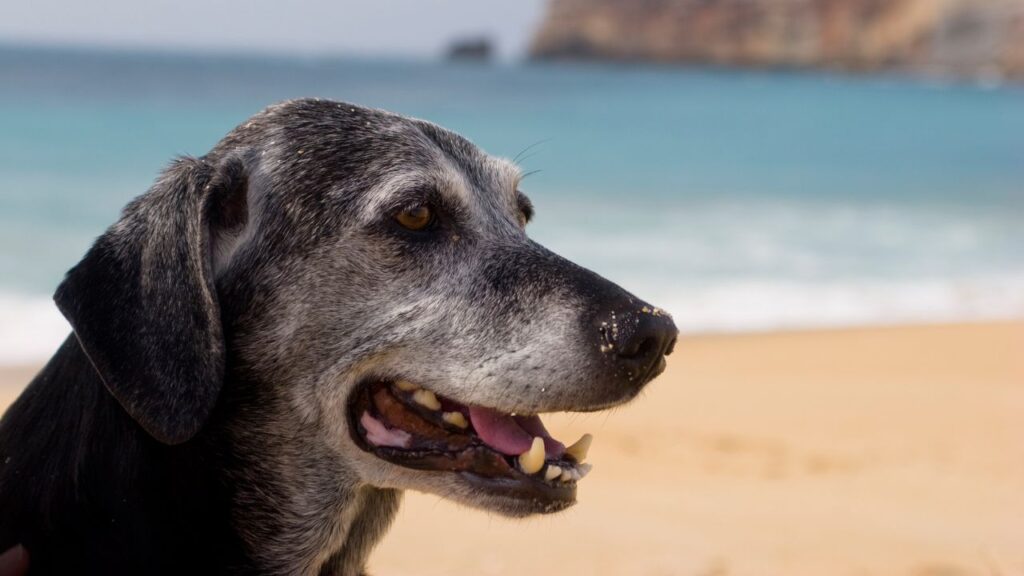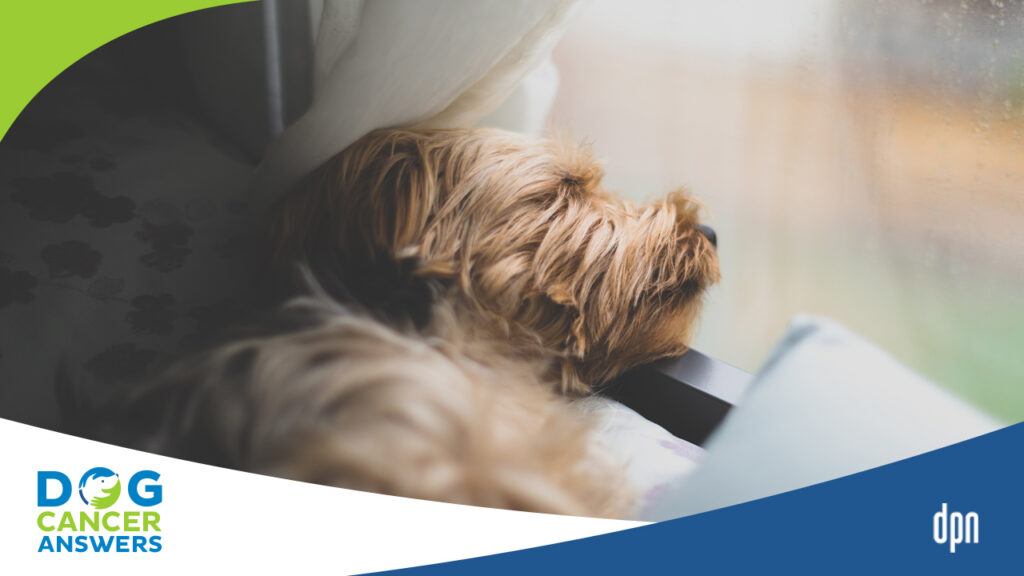It is important to trust your instincts and permit yourself to sit with all the possible options after finding out your beloved dog has cancer. Choose the best plan for your dog’s well-being and self-care, which may mean not treating dog cancer at all. That choice is OK!
Key Takeaways
- Choosing not to treat cancer may be the best choice you can make for your dog.
- Hospice care may even help with longevity.
- If you are facing limited or ineffective treatment options, it’s reasonable and even good to choose to prioritize comfort over aggressive treatment.
- If your dog is miserable at the veterinarian, or doesn’t tolerate treatments well, it’s perfectly reasonable to stop them.
- Other serious health issues can interfere with successful treatment, and so can lack of access to good care.
- Having open and honest conversations with your veterinarian that take your dog’s age, overall health, and your ability to provide care, is important. If you are having those discussions and deciding to prioritize comfort, you will have few or no regrets looking back.
Why You Might Not Want to Treat Dog Cancer
There are many reasons why you may elect not to pursue treatment if your dog is diagnosed with cancer. Not treating dog cancer is often a reasonable choice; sometimes, it’s the best choice for you and your dog.
In this article, we’ll go over some of the most important things for you to know as you face your dog’s cancer diagnosis.
You Care About Your Dog Even If You Don’t Treat Dog Cancer
Choosing not to treat does not mean you do not care about your dog. Instead, you are shifting focus from curative or life-prolonging efforts to prioritizing comfort.
Your Quality of Life Matters Immensely
Some studies have found that pet owners’ quality of life and priorities influence their pets’ quality of life. Thus, it is not only OK but essential to consider how dealing with the cancer diagnosis will affect the entire family caring for that dog.1,2
Veterinarians Don’t Judge Those Who Don’t Treat
You may be surprised, but veterinarians or veterinary oncologists do not always recommend treatment.
What is important is that you have an open and honest conversation with your veterinarian about treatment options, pros and cons, and expected survival time with and without treatment, so you can make an informed decision that you feel is best for you and your dog.
Dr. Demian Dressler helps folks treat dog cancer aggressively, and he also defends the choice to forgo treatments and just enjoy your dog. A must-listen episode..
When There Are No Great Treatment Options
Many of us think that because we always attempt to treat cancer in humans, we should do the same for dogs. But for some dog cancers, there may not be reasonable treatment options. If your dog has advanced aggressive cancer, a rare cancer, or a cancer with a very poor long-term prognosis, treatment may not be the best option.
In some cases, existing treatments may have poor outcomes with a high risk of side effects. In these cases, declining treatment may actually be the best course of action.
One needs to weigh the risks and benefits of a particular treatment, and how it will affect the quality of your dog’s life.
When Veterinary Visits Are Stressful
The stress of veterinary visits is also a factor to consider. Suppose you have a dog who is extremely anxious at the vet’s office or in the car, and treatment involves daily visits to the oncologist.
You might not want to put your dog through that treatment schedule, which is a perfectly reasonable decision. In that case, you may decide that in the long run, you would rather have fewer days, weeks or months, but with a happier, more relaxed dog.
Even if you do treat, the fear and discomfort at the vet may be unnecessary for your dog to endure during their final days, weeks, or months.
It might be helpful for you to know that dogs who are stressed at the hospital may have an increase in vital parameters like heart rate and blood pressure,3 and chronically elevated stress hormones can influence overall health. Those stressful vet visits may affect them long after they’re back home.
It’s OK to prioritize bucket list items like trips to the park or the lake over trips to the vet if they are unpleasant for your dog.
When Your Dog Doesn’t Tolerate the Treatment(s)
The goal of cancer treatment in our pets is generally not to cure but to extend life while preserving or increasing the quality of life.
Unfortunately, that does not always happen despite our best efforts.
- Chemotherapy, radiation, surgery, and medications all have potential side effects.
- Dogs tend to tolerate chemotherapy very well. However, common adverse effects of chemo include gastrointestinal upset and decreased neutrophils (a vital white blood cell), which can increase the risk of secondary infections.
- Radiation can have acute and chronic side effects, including pain.
- Some dogs are extremely difficult to medicate at home and may spit out pills or struggle when you attempt to give a medication. This extra stress and daily drama may not be worth the benefits of the medications.
If your dog is not doing well with a certain treatment, simply not treating dog cancer so you can prioritize comfort may be your best decision.
In fact, quality of life evaluation is being integrated as an important monitoring tool for pets receiving chemotherapy. If your pet’s quality of life is decreased, it may indicate that it is time to stop treatment.4
Not Treating Dog Cancer Because of Other Serious Health Problems
Another reason to stop and consider if treatment is right for your dog is if they have other health issues that may increase their risk for adverse effects or treatment failure.
Suppose your dog has comorbidities like chronic kidney disease (CKD), chronic liver disease, heart disease, Cushing’s disease, seizures, or severe anxiety. In that case, you may have to weigh the risks of certain treatments with a different mindset.
Your veterinary team can help you weigh the risks of mixing other serious disease processes and cancer treatment. Veterinary oncologists are specially trained to manage underlying conditions while maintaining a good quality of life in pets with cancer.

When It’s Difficult to Access Care
Access to care can be another roadblock to treatment. The availability of treatment options may be difficult due to geographic location and/or time constraints.
Ask yourself: what time and energy will treatment take for you and your family?
- It may be that the closest veterinary oncologist is hours away, so weekly or daily treatments are not feasible.
- Radiation protocols can be particularly demanding in terms of frequency of treatment.
- It may be that your work schedule does not align with the available treatment hours.
These daily logistical realities must be considered and can (and should) influence your choice to treat. Talk to your veterinary team about your time and travel limitations and see if a treatment plan fits your schedule and your dog’s needs.
But what if you can’t make a plan that really works? It’s good to forgo treatment, we think.
Choosing the extra hour you have at the end of the day to take a walk or snuggle with your dog may be the best for both of you in the end. If you can’t get your dog to treatments, not treating dog cancer makes all the sense in the world.
Pain expert Tasha McNerney reveals how negative emotions can increase pain in the body. Fascinating and so helpful!
When There Are Financial Limitations
We all understand that advanced veterinary care can be expensive. A personal financial situation may make treatment impossible without threatening you and/or your family’s well-being.
If you are reading this article, it is already clear you love and care about your dog, so choosing not to treat dog cancer is understandable, and you should not further punish yourself for having to make such a decision.
Remember, veterinarians are trained to offer each patient the gold standard as an option, but that does not mean that they expect you (or even want you) to choose that path.
Unfortunately, it is common for veterinarians to rely on clients to initiate a conversation about finances.6 Veterinarians are working to change that, but in the meantime, do not hesitate to ask your veterinarian about cost and payment options like CareCredit or ScratchPay.6
It may be possible to get funds together from donation funds or to reach out to other organizations with the mission to assist in these situations. There are also likely other treatment options available that may have a different success rate but still provide your dog a chance to feel better.
Only you know your financial limits. Your ability to care for yourself and others who depend on you is vitally important. Everyone has financial limitations, and you should never feel pressured to exceed your limitations.
Is This for My Dog or Me?
When deciding to treat, always ask: Is this for me or my dog?
Dogs do not experience illness exactly like we do. They are lucky enough to live in the present. They don’t worry about the past, future, or median survival times.
If pursuing aggressive treatment will cause daily pain without a good long-term outcome, all your dog will experience is daily pain.
Consider it from a dog’s perspective: if you didn’t have the foresight to understand the potential benefits of a treatment protocol, would you be willing to endure it if it were scary, invasive, or separated you from your favorite people?
The right choice is too often not the easy choice when it comes to our beloved pets.
Focusing on Quality of Life and Hospice Care
Whether or not you choose to treat, taking the time to be thoughtful about your dog’s quality of life toward the end is very beneficial. We recommend using a chart or log to track life quality right after you find out your dog has cancer.
Having a more qualitative (numbers-based) approach to quality of life can be very helpful. Seeing your notes in black and white can remove the lens of emotion that can skew objectivity. When you are living with your dog and seeing small changes every day, the definition of “normal” can slide quickly without notice unless you deliberately track it.
Fill your log out daily or weekly. You can include quality of life parameters such as minutes spent taking a walk, being interactive with family members, appetite, accidents in the house, ease of mobility, and more.
Hospice care doesn’t worry so much about treating the exact disease that your dog has but instead focuses on relieving symptoms and keeping your dog happy and comfortable.
Your regular veterinarian can help guide you through providing hospice care for your dog at home, and some veterinarians focus specifically on hospice and end-of-life care.
These vets can help guide you through this stage of your dog’s journey and ensure your pet is comfortable. It is important to remember the goal is quality of life, not quantity.
When guilt inevitably arises, as it will, because you a human who loves your dog, please go easy on yourself. Do not blame yourself for not being able to do more. Your love for your dog is enough.
Dr. Demian Dressler and veterinary oncologist Dr. Sue Ettinger discuss why we feel so guilty about dog cancer, and how to cope with it.
- Oyama MA, Rush JE, O’Sullivan ML, et al. Perceptions and priorities of owners of dogs with heart disease regarding quality versus quantity of life for their pets. J Am Vet Med Assoc. 2008;233(1):104-108. doi:10.2460/javma.233.1.104
- Linek M, Favrot C. Impact of canine atopic dermatitis on the health-related quality of life of affected dogs and quality of life of their owners. Vet Dermatol. 2010;21(5):456-462. doi:10.1111/j.1365-3164.2010.00899.x
- Bragg RF, Bennett JS, Cummings A, Quimby JM. Evaluation of the effects of hospital visit stress on physiologic variables in dogs. Journal of the American Veterinary Medical Association. 2015;246(2):212-215. doi:10.2460/javma.246.2.212
- Vøls KK, Heden MA, Kristensen AT, Sandøe P. Quality of life assessment in dogs and cats receiving chemotherapy – a review of current methods. Veterinary and Comparative Oncology. 2016;15(3):684-691. doi:10.1111/vco.12242
- Tollett MA, Duda L, Brown DC, Krick EL. Palliative radiation therapy for solid tumors in dogs: 103 cases (2007–2011). Journal of the American Veterinary Medical Association. 2016;248(1):72-82. doi:10.2460/javma.248.1.72
- Janke N, Coe JB, Bernardo TM, Dewey CE, Stone EA. Pet owners’ and veterinarians’ perceptions of information exchange and clinical decision-making in companion animal practice. Clegg S, ed. PLOS ONE. 2021;16(2):e0245632. doi:10.1371/journal.pone.0245632
- Fulmer AE, Laven LJ, Hill KE. Quality of Life Measurement in Dogs and Cats: A Scoping Review of Generic Tools. Animals (Basel). 2022;12(3):400. Published 2022 Feb 8. doi:10.3390/ani12030400
- Niessen SJ, Powney S, Guitian J, et al. Evaluation of a quality-of-life tool for dogs with diabetes mellitus. J Vet Intern Med. 2012;26(4):953-961. doi:10.1111/j.1939-1676.2012.00947.x
- Schofield I, O’Neill DG, Brodbelt DC, Church DB, Geddes RF, Niessen SJM. Development and evaluation of a health-related quality-of-life tool for dogs with Cushing’s syndrome. J Vet Intern Med. 2019;33(6):2595-2604. doi:10.1111/jvim.15639
- Iliopoulou MA, Kitchell BE, Yuzbasiyan-Gurkan V. Development of a survey instrument to assess health-related quality of life in small animal cancer patients treated with chemotherapy. J Am Vet Med Assoc. 2013;242(12):1679-1687. doi:10.2460/javma.242.12.1679
Topics
Did You Find This Helpful? Share It with Your Pack!
Use the buttons to share what you learned on social media, download a PDF, print this out, or email it to your veterinarian.







